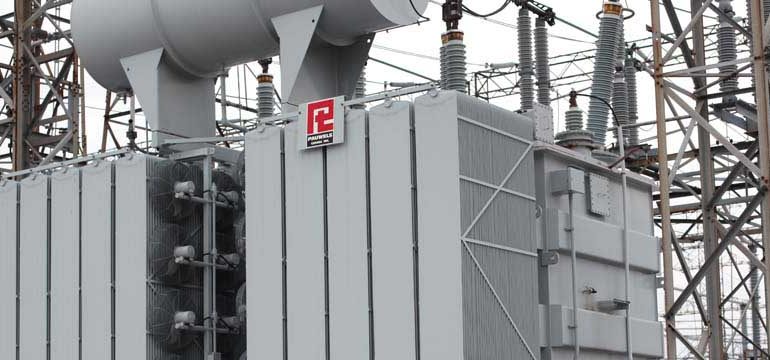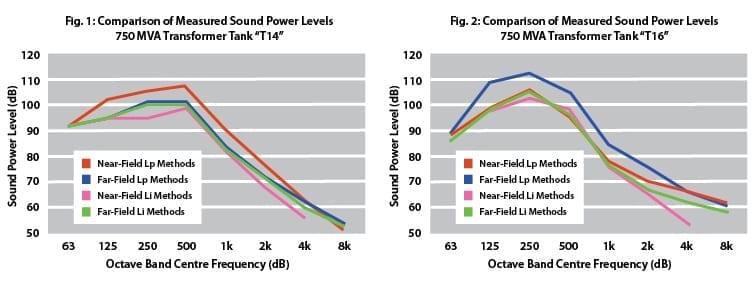Sound Power Measurements of Large Electrical Transformers

The industry-standard method for quantifying the sound emission levels of electrical transformers is outlined in IEEE Standard C57.12.90, which details a procedure requiring sound pressure measurements at specified near-field distances and elevations surrounding a transformer. Despite widespread use of these measurement methods throughout the industry, recent field experience by HGC has shown that measurements of sound pressure levels conducted at these specified measurement distances can result in overestimated sound power levels, as determined by far-field sound measurements.
Sound intensity measurements
Sound intensity measurements of transformers were also employed, using methods from ISO Standard 9614-1, which have also verified that the near-field sound pressure measurements can result in overestimated sound levels. This is thought to be a result of the acoustic reactivity in the near-field of the transformer tank. To improve the accuracy of acoustical measurements of transformers, ISO Standard 9614-2, along with elements from IEC Standards 60076-10 and 60076-10-1 have been employed by our acoustical consultants, and have shown improved results.
“Our study strongly suggests that sound pressure measurements conducted according to IEEE Standard C57.12.90 should be treated as suspect, and used with caution.”
Sound emission measurement standards for transformers
The standard most commonly used in industry to measure sound emissions of transformers is IEEE Standard C57.12.90,. The measurement locations specified in this standard are relatively very close to the transformer tank (0.3 metres in the absence of cooling fans). Presumably this close offset distance was chosen to minimize potential interference from background sound and room reverberation in situations where the transformer would be measured indoors – perhaps in the manufacturer’s plant. However, the findings of this study indicate that the measurement positions specified in IEEE Standard C57.12.90, may be too close, tending to result in overestimates of sound emissions, because of near-field acoustic reactivity.
The acoustic near-field is the zone around a sound source where the distance to the radiating surface of the source is less than the wavelength of sound. In this zone, the sound field is complex, and there are “reactive” components of sound pressure which do not propagate to the far field.
In the past five years, HGC staff has had the opportunity to conduct acoustical measurements of more than 100 large electrical transformers throughout the province of Ontario as an acoustical consulting support partner to Hydro One, the province’s sole electrical power distributor. In general, sound intensity measurement techniques have been utilized to measure the at-source sound levels of the transformers and any other sound producing equipment within the stations, and sound pressure measurement techniques have been used to measure far-field sound levels for verification purposes.

The specific measurement data that formed the basis of this study, resulted from circumstances in which the IEEE near-field sound pressure method was used by others to measure the in-situ sound emissions of two large 750 MVA transformers. The results of these measurements seemed at odds with a series of far-field measurements. In order to investigate this discrepancy, our acoustical consultants had the opportunity to re-measure the sound emissions of the transformers using both sound pressure and sound intensity methods from ISO Standard 9614-1, simultaneously at the near-field locations specified by IIEEE Standard C57.12.90 and far-field locations suggested by IEC Standard 60076-10-1
Sound pressure measurements vs sound intensity measurements
A comparison of the various measurement results indicates that sound pressure measurements in the near-field tend to overestimate the sound power emission levels of the transformer by as much as 10 to 12 dB, whereas the near-field sound intensity measurements and far-field pressure and sound intensity measurements do not.
Therefore, our study strongly suggests that sound pressure measurements conducted according to IEEE Standard C57.12.90 should be treated as suspect, and used with caution. Our findings indicate that it is preferable either to use sound intensity methods for near-field measurements, or to select measurement locations further from the transformer, as per IEC Standard 60076-10-1, if sound pressure methods are to be used.
